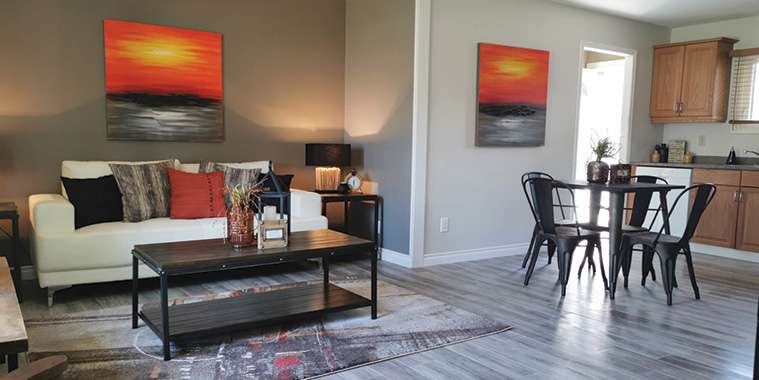by Angie Kendel
How we live in a home is very different from how we show a home for sale. One of the most frequent questions I am asked is about “rules” for design. Although certain rules apply for walkways, furniture placement, lighting, etc,. how a space is being used determines how these rules apply.
Cohesive design is all about creating a functional space that enhances the family’s ability to use that space. How one family may need to use an area may be very different from how another family may use it. Design for living is a very custom approach for your family in a specific section.
However, when it comes to design for selling, we are trying to design a space that appeals to largest number of potential buyers. The homeowners’ personal preferences are no longer the deciding factor in the design.
The whole purpose of staging a home for sale is to have the home appeal to as many people as possible. The more interest, the better the chance of obtaining several offers and a quick sale for the seller. The less personal a home appears, the easier it is for others to see themselves living in your house. We try to neutralize many personal aspects of a home when we stage. This includes removing personal pictures, decluttering living spaces and storage spaces, and showcasing living areas as spacious and functional.
It is common for families to have multi-function areas in their homes. A family room can have a TV area, play space for young children and a computer area for the family. When showing a home for sale, we typically have dedicated rooms. A family room is strictly a sitting area with a TV. Children’s toys are removed, and computers are removed. This declutters the room and helps showcase how large a space often is. Once a space is decluttered, we then ensure the furniture placement showcases the space, and the appropriate décor gives that high-value “wow” factor first impression.
This high impact first impression is what creates the emotional connection for buyers to your home. Seeing the potential in a space is so much more powerful than seeing how someone else lives in a space.
When we design for living, it is all about customizing the design for the client. Who uses the space? What functions do you need the space to fulfill for your family? Will you be watching TV, doing homework, entertaining guests or all of the above? What are your personal likes and dislikes? How many people must the space accommodate at any given time? How do you see the space being used for holidays or extended family gatherings? What additional special scenarios must we take into consideration to design you a space that works now and for years to come?
Design for living is very personal for that family and gets more specific for each individual room. Each family member has their own space as well as common areas. Blending the needs and wishes of all family members makes for a very intricate design. However, when done successfully, we have a family that loves their space!
Last year, we designed a kitchen for a client that was experiencing degenerative eyesight. We removed walls for a more open concept to ensure it was easier to move around in the space with fewer obstacles. We also incorporated an abundance of lighting and natural light to minimize the strain on her eyes. We also incorporated highly visible areas with contrasting colours that would be easier to distinguish. We chose handles that were easier to grip and locate rather than a small handle. Everything was planned around ease of use and highly functional while still selecting a beautiful design that enhanced their home. It was very appealing for resale and highly functional for the existing homeowner. Design that works today and tomorrow!
There are many ways to customize a design while still ensuring that the home can sell easily with minimal changes. Most sellers expect to do some decluttering and removal of personal items when selling. When planning a major renovation, just remember to keep the permanent aspects like flooring, cabinets, paint and counters neutral enough to be appealing to a wide group of people. If you like bold colours, feel free to use these in accents and décor that are easily changed like artwork, pillows, bedding, rugs, and décor accents. This way you enjoy your favorite colours without the huge expense of changing anything major when it comes time to sell. After all, the less you have to do to prepare your home for sale, the less stressful you will find the process! Happy designing!



